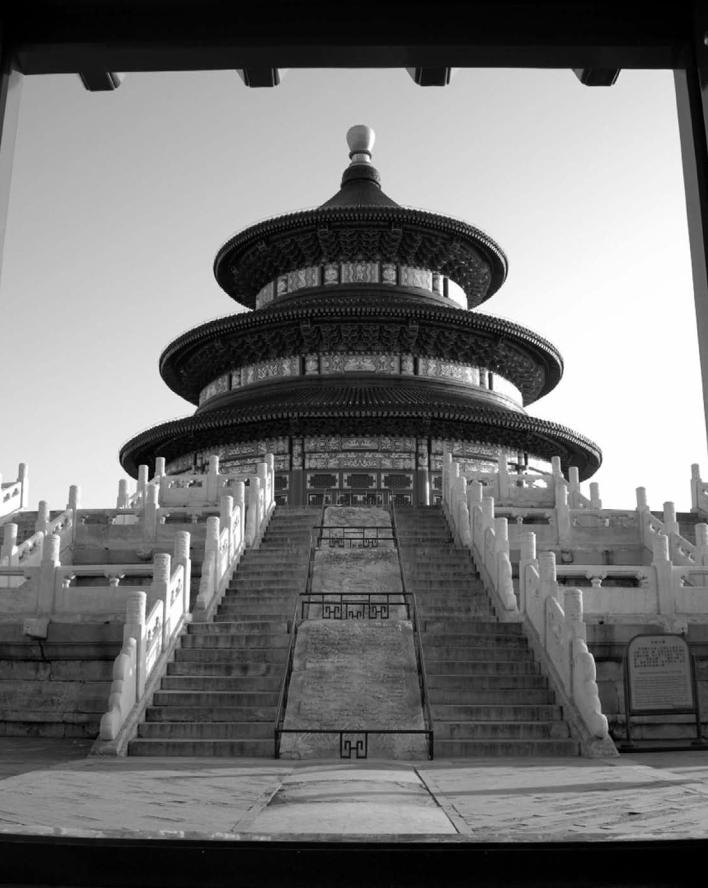
- •CONTENTS
- •INTRODUCTION
- •PREHISTORY
- •EARLY HUMANS
- •NEOLITHIC PERIOD
- •CLIMATE AND ENVIRONMENT
- •FOOD PRODUCTION
- •MAJOR CULTURES AND SITES
- •INCIPIENT NEOLITHIC
- •THE FIRST HISTORICAL DYNASTY: THE SHANG
- •THE SHANG DYNASTY
- •THE HISTORY OF THE ZHOU (1046–256 BC)
- •THE ZHOU FEUDAL SYSTEM
- •SOCIAL, POLITICAL, AND CULTURAL CHANGES
- •THE DECLINE OF FEUDALISM
- •THE RISE OF MONARCHY
- •ECONOMIC DEVELOPMENT
- •CULTURAL CHANGE
- •THE QIN EMPIRE (221–207 BC)
- •THE QIN STATE
- •STRUGGLE FOR POWER
- •THE EMPIRE
- •DYNASTIC AUTHORITY AND THE SUCCESSION OF EMPERORS
- •XI (WESTERN) HAN
- •DONG (EASTERN) HAN
- •THE ADMINISTRATION OF THE HAN EMPIRE
- •THE ARMED FORCES
- •THE PRACTICE OF GOVERNMENT
- •RELATIONS WITH OTHER PEOPLES
- •CULTURAL DEVELOPMENTS
- •THE DIVISION OF CHINA
- •DAOISM
- •BUDDHISM
- •THE SUI DYNASTY
- •INTEGRATION OF THE SOUTH
- •EARLY TANG (618–626)
- •ADMINISTRATION OF THE STATE
- •FISCAL AND LEGAL SYSTEM
- •THE PERIOD OF TANG POWER (626–755)
- •RISE OF THE EMPRESS WUHOU
- •PROSPERITY AND PROGRESS
- •MILITARY REORGANIZATION
- •LATE TANG (755–907)
- •PROVINCIAL SEPARATISM
- •CULTURAL DEVELOPMENTS
- •THE INFLUENCE OF BUDDHISM
- •TRENDS IN THE ARTS
- •SOCIAL CHANGE
- •DECLINE OF THE ARISTOCRACY
- •POPULATION MOVEMENTS
- •GROWTH OF THE ECONOMY
- •THE WUDAI (FIVE DYNASTIES)
- •THE SHIGUO (TEN KINGDOMS)
- •BARBARIAN DYNASTIES
- •THE TANGUT
- •THE KHITAN
- •THE JUCHEN
- •BEI (NORTHERN) SONG (960–1127)
- •UNIFICATION
- •CONSOLIDATION
- •REFORMS
- •DECLINE AND FALL
- •SURVIVAL AND CONSOLIDATION
- •RELATIONS WITH THE JUCHEN
- •THE COURT’S RELATIONS WITH THE BUREAUCRACY
- •THE CHIEF COUNCILLORS
- •THE BUREAUCRATIC STYLE
- •THE CLERICAL STAFF
- •SONG CULTURE
- •INVASION OF THE JIN STATE
- •INVASION OF THE SONG STATE
- •CHINA UNDER THE MONGOLS
- •YUAN CHINA AND THE WEST
- •THE END OF MONGOL RULE
- •POLITICAL HISTORY
- •THE DYNASTY’S FOUNDER
- •THE DYNASTIC SUCCESSION
- •LOCAL GOVERNMENT
- •CENTRAL GOVERNMENT
- •LATER INNOVATIONS
- •FOREIGN RELATIONS
- •ECONOMIC POLICY AND DEVELOPMENTS
- •POPULATION
- •AGRICULTURE
- •TAXATION
- •COINAGE
- •CULTURE
- •PHILOSOPHY AND RELIGION
- •FINE ARTS
- •LITERATURE AND SCHOLARSHIP
- •THE RISE OF THE MANCHU
- •THE QING EMPIRE
- •POLITICAL INSTITUTIONS
- •FOREIGN RELATIONS
- •ECONOMIC DEVELOPMENT
- •QING SOCIETY
- •SOCIAL ORGANIZATION
- •STATE AND SOCIETY
- •TRENDS IN THE EARLY QING
- •POPULAR UPRISING
- •THE TAIPING REBELLION
- •THE NIAN REBELLION
- •MUSLIM REBELLIONS
- •EFFECTS OF THE REBELLIONS
- •INDUSTRIALIZATION FOR “SELF-STRENGTHENING”
- •CHANGES IN OUTLYING AREAS
- •EAST TURKISTAN
- •TIBET AND NEPAL
- •MYANMAR (BURMA)
- •VIETNAM
- •JAPAN AND THE RYUKYU ISLANDS
- •REFORM AND UPHEAVAL
- •THE BOXER REBELLION
- •REFORMIST AND REVOLUTIONIST MOVEMENTS AT THE END OF THE DYNASTY
- •EARLY POWER STRUGGLES
- •CHINA IN WORLD WAR I
- •INTELLECTUAL MOVEMENTS
- •THE INTERWAR YEARS (1920–37)
- •REACTIONS TO WARLORDS AND FOREIGNERS
- •THE EARLY SINO-JAPANESE WAR
- •PHASE ONE
- •U.S. AID TO CHINA
- •NATIONALIST DETERIORATION
- •COMMUNIST GROWTH
- •EFFORTS TO PREVENT CIVIL WAR
- •CIVIL WAR (1945–49)
- •A RACE FOR TERRITORY
- •THE TIDE BEGINS TO SHIFT
- •COMMUNIST VICTORY
- •RECONSTRUCTION AND CONSOLIDATION, 1949–52
- •THE TRANSITION TO SOCIALISM, 1953–57
- •RURAL COLLECTIVIZATION
- •URBAN SOCIALIST CHANGES
- •POLITICAL DEVELOPMENTS
- •FOREIGN POLICY
- •NEW DIRECTIONS IN NATIONAL POLICY, 1958–61
- •READJUSTMENT AND REACTION, 1961–65
- •THE CULTURAL REVOLUTION, 1966–76
- •ATTACKS ON CULTURAL FIGURES
- •ATTACKS ON PARTY MEMBERS
- •SEIZURE OF POWER
- •SOCIAL CHANGES
- •STRUGGLE FOR THE PREMIERSHIP
- •CHINA AFTER THE DEATH OF MAO
- •DOMESTIC DEVELOPMENTS
- •INTERNATIONAL RELATIONS
- •RELATIONS WITH TAIWAN
- •CONCLUSION
- •GLOSSARY
- •FOR FURTHER READING
- •INDEX
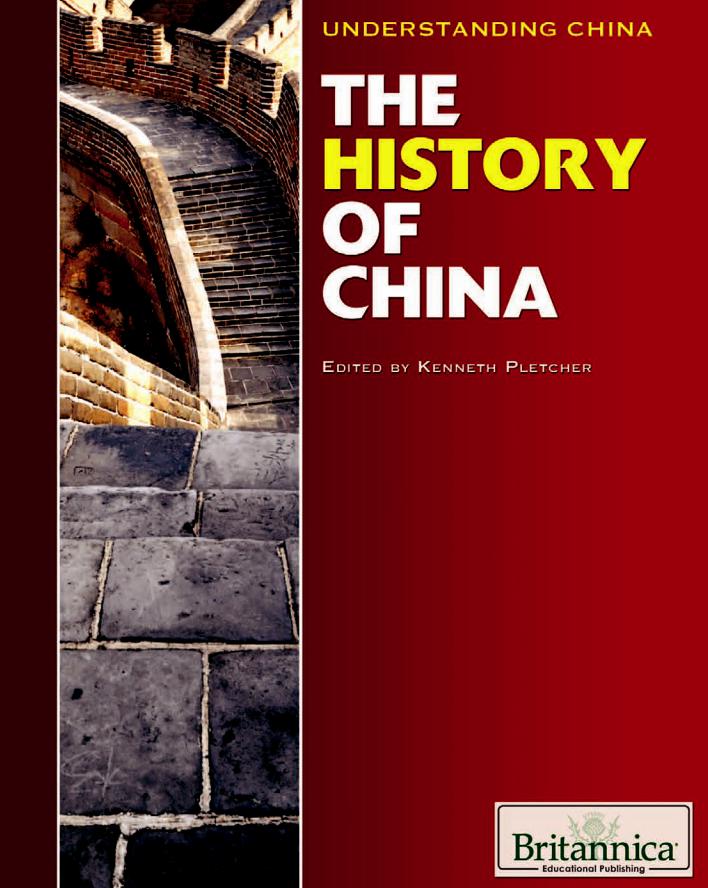

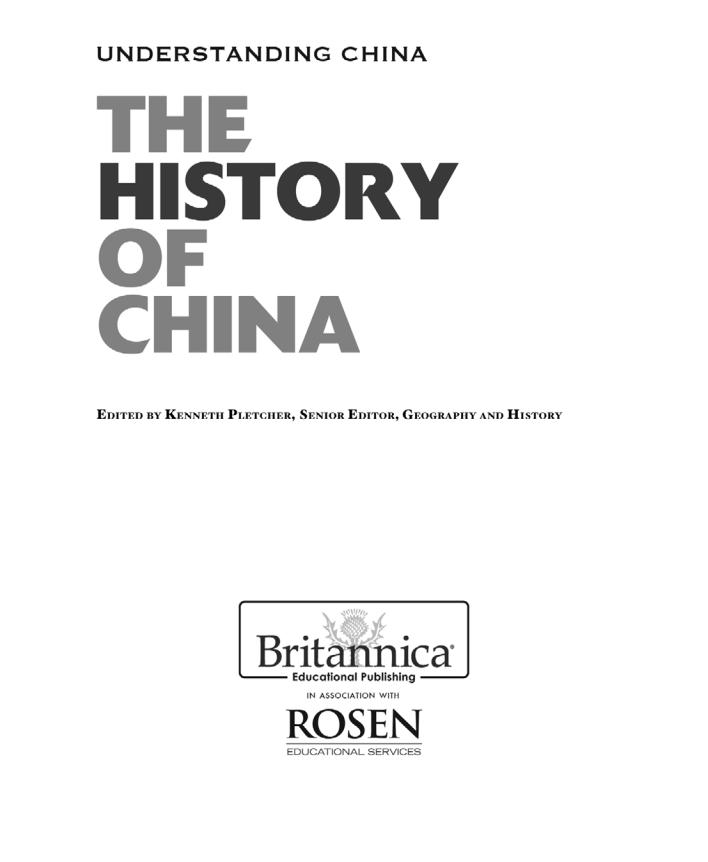

Published in 2011 by Britannica Educational Publishing (a trademark of Encyclopædia Britannica, Inc.)
in association with Rosen Educational Services, LLC 29 East 21st Street, New York, NY 10010.
Copyright © 2011 Encyclopædia Britannica, Inc. Britannica, Encyclopædia Britannica, and the Thistle logo are registered trademarks of Encyclopædia Britannica, Inc. All rights reserved.
Rosen Educational Services materials copyright © 2011 Rosen Educational Services, LLC. All rights reserved.
Distributed exclusively by Rosen Educational Services.
For a listing of additional Britannica Educational Publishing titles, call toll free (800) 237-9932.
First Edition
Britannica Educational Publishing
Michael I. Levy: Executive Editor
J.E. Luebering: Senior Manager
Marilyn L. Barton: Senior Coordinator, Production Control
Steven Bosco: Director, Editorial Technologies
Lisa S. Braucher: Senior Producer and Data Editor
Yvette Charboneau: Senior Copy Editor
Kathy Nakamura: Manager, Media Acquisition
Kenneth Pletcher: Senior Editor, Geography and History
Rosen Educational Services
Alexandra Hanson-Harding: Senior Editor
Nelson Sá: Art Director
Cindy Reiman: Photography Manager
Nicole Russo: Designer
Matthew Cauli: Cover Design
Introduction by Laura La Bella
Library of Congress Cataloging-in-Publication Data
The history of China / edited by Kenneth Pletcher.—1st ed. p. cm.—(Understanding China)
“In association with Britannica Educational Publishing, Rosen Educational Services.” Includes bibliographical references and index.
ISBN 978-1-61530-181-2 (eBook)
1. China—History—Juvenile literature. I. Pletcher, Kenneth. DS735.H56 2010
951—dc22
2009046655
On the cover: The Great Wall, China’s most famous landmark, was built over a period of more than 2,000 years. © www.istockphoto.com/Robert Churchill
Page 14 © www.istockphoto.com/Hanquan Chen.
On page 20: The Hall of Prayer for Good Harvests, part of a large religious complex called the Temple of Heaven, was built in 1420 in Beijing. © www.istockphoto.com/Hanquan Chen
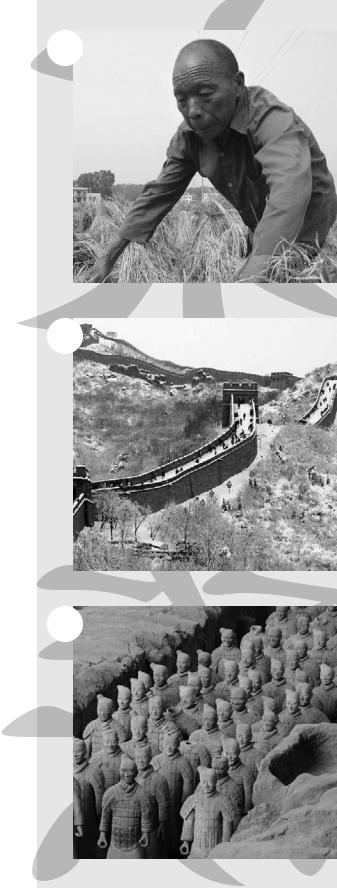
CONTENTS
Introduction |
14 |
Chapter i: The Beginnings |
|
of Chinese history |
21 |
Introduction |
21 |
Prehistory |
22 |
Early Humans |
22 |
Neolithic Period |
24 |
Climate and Environment |
24 |
Food Production |
25 |
Major Cultures and Sites |
26 |
Incipient Neolithic |
26 |
Silk |
27 |
Religious Beliefs |
|
and Social Organization |
32 |
The First Historical Dynasty: The Shang |
33 |
The Advent of Bronze Casting |
33 |
The Shang Dynasty |
35 |
Royal Burials |
36 |
The Chariot |
37 |
Art |
37 |
Late Shang Divination and Religion |
38 |
State and Society |
39 |
Chapter 2: The Zhou |
|
and Qin Dynasties |
41 |
The History of the Zhou (1046–256 BC) |
41 |
Zhou and Shang |
42 |
The Zhou Feudal System |
44 |
Social, Political, and Cultural Changes |
47 |
The Decline of Feudalism |
47 |
Urbanization and Assimilation |
47 |
The Rise of Monarchy |
48 |
Economic Development |
50 |
Cultural Change |
53 |
The Qin Empire (221–207 BC) |
54 |
The Qin State |
54 |
Struggle for Power |
55 |
The Empire |
56 |
The Great Wall of China |
57 |
25
57
59

Chapter 3: The han Dynasty |
60 |
Dynastic Authority and |
|
the Succession of Emperors |
61 |
Xi (Western) Han |
61 |
Prelude to the Han |
62 |
The Imperial Succession |
63 |
From Wudi to Yuandi |
65 |
Wudi |
65 |
From Chengdi to Wang Mang |
66 |
Dong (Eastern) Han |
67 |
The Administration of the Han Empire |
69 |
The Structure of Government |
69 |
The Civil Service |
69 |
Provincial Government |
71 |
The Armed Forces |
72 |
The Practice of Government |
73 |
Relations with Other Peoples |
76 |
Cultural Developments |
78 |
Chapter 4: The Six Dynasties |
|
and the Sui Dynasty |
83 |
Political Developments |
|
During the Six Dynasties |
83 |
The Division of China |
83 |
Sanguo (Three Kingdoms; AD 220–280) |
84 |
The Xi (Western) Jin (AD 265–316/317) |
84 |
The Era of Barbarian Invasions and Rule |
85 |
The Dong (Eastern) Jin (317–420) and |
|
Later Dynasties in the South (420–589) |
85 |
The Shiliuguo (Sixteen Kingdoms) |
|
in the North (303–439) |
86 |
Intellectual and Religious Trends |
|
During the Six Dynasties |
87 |
Confucianism and Philosophical Daoism |
87 |
Confucius |
88 |
Daoism |
90 |
Buddhism |
92 |
The Sui Dynasty |
95 |
Wendi’s Institutional Reforms |
96 |
Integration of the South |
97 |
Foreign Affairs Under Yangdi |
100 |
73
81
93
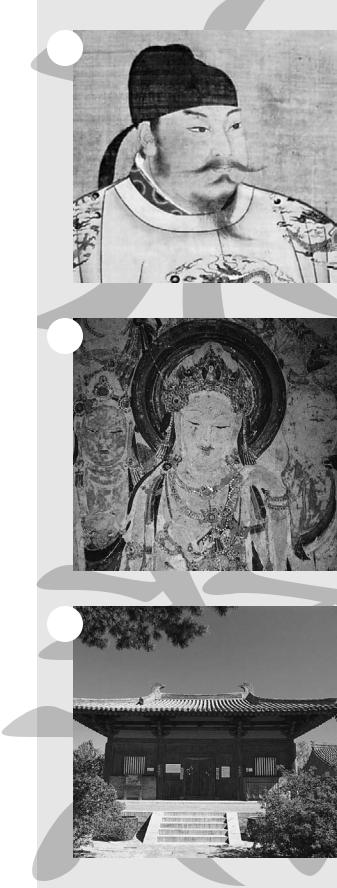
Chapter 5: The Tang Dynasty |
102 |
Early Tang (618–626) |
102 |
Administration of the State |
104 |
Fiscal and Legal System |
105 |
The Period of Tang Power (626–755) |
107 |
The “Era of Good Government” |
107 |
Rise of the Empress Wuhou |
110 |
Prosperity and Progress |
114 |
Military Reorganization |
115 |
Late Tang (755–907) |
117 |
Provincial Separatism |
118 |
The Struggle for Central Authority |
120 |
Cultural Developments |
122 |
The Influence of Buddhism |
122 |
Trends in the Arts |
125 |
Du Fu |
125 |
Social Change |
126 |
Decline of the Aristocracy |
126 |
Population Movements |
127 |
Growth of the Economy |
128 |
Chapter 6: Political Disunity
Between the Tang and Song Dynasties 130
The Five Dynasties and the Ten Kingdoms |
130 |
The Wudai (Five Dynasties) |
131 |
Huang He |
132 |
The Shiguo (Ten Kingdoms) |
133 |
Barbarian Dynasties |
135 |
The Tangut |
135 |
The Khitan |
135 |
The Juchen |
136 |
Chapter 7: The Song Dynasty |
138 |
Bei (Northern) Song (960–1127) |
138 |
Unification |
138 |
Consolidation |
140 |
Reforms |
142 |
Decline and Fall |
145 |
Nan (Southern) Song (1127–1279) |
147 |
Survival and Consolidation |
148 |
Relations with the Juchen |
150 |
108
123
124
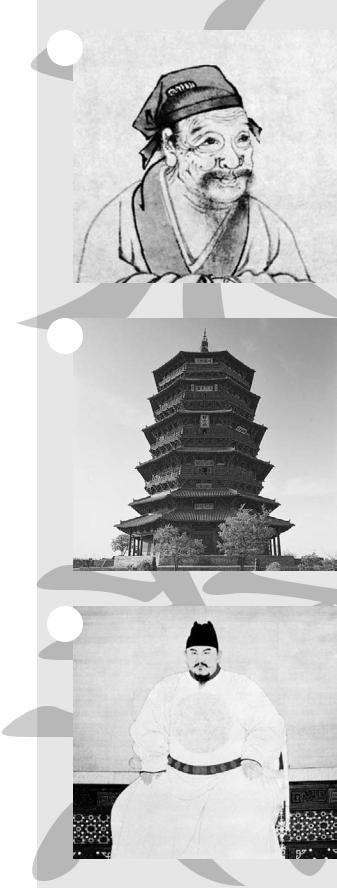
The Court’s Relations with the Bureaucracy |
151 |
The Chief Councillors |
153 |
The Bureaucratic Style |
155 |
Chinese Civil Service |
157 |
The Clerical Staff |
158 |
The Rise of Neo-Confucianism |
159 |
Internal Solidarity During |
|
the Decline of the Nan Song |
162 |
Song Culture |
163 |
Chapter 8: The yuan, |
|
or Mongol, Dynasty |
168 |
The Mongol Conquest of China |
168 |
Invasion of the Jin State |
168 |
Genghis Khan |
169 |
Invasion of the Song State |
170 |
China Under the Mongols |
172 |
Mongol Government and Administration |
172 |
Early Mongol Rule |
172 |
Changes Under Kublai Khan |
|
and His Successors |
173 |
Economy |
177 |
Religious and Intellectual Life |
178 |
Daoism |
178 |
Buddhism |
180 |
Foreign Religions |
181 |
Confucianism |
181 |
Literature |
182 |
The Arts |
183 |
Yuan China and the West |
186 |
The End of Mongol Rule |
188 |
Chapter 9: The Ming Dynasty |
190 |
Political History |
190 |
The Dynasty’s Founder |
191 |
Hongwu |
192 |
The Dynastic Succession |
192 |
Government and Administration |
196 |
Local Government |
197 |
Central Government |
197 |
Later Innovations |
198 |
160
179
191

Foreign Relations |
201 |
Economic Policy and Developments |
205 |
Population |
205 |
Agriculture |
206 |
Taxation |
207 |
Coinage |
208 |
Culture |
208 |
Philosophy and Religion |
209 |
Fine Arts |
211 |
Literature and Scholarship |
211 |
Chapter 10: The Early Qing Dynasty |
214 |
The Rise of the Manchu |
214 |
Dorgon |
217 |
The Qing Empire |
217 |
Political Institutions |
218 |
Foreign Relations |
222 |
Economic Development |
223 |
Qing Society |
226 |
Social Organization |
228 |
State and Society |
229 |
Trends in the Early Qing |
230 |
Chapter 11: Late Qing |
231 |
Western Challenge, 1839–60 |
231 |
The First Opium War and its Aftermath |
232 |
The Antiforeign Movement |
|
and the Second Opium War (Arrow War) |
234 |
Popular Uprising |
236 |
The Taiping Rebellion |
236 |
The Nian Rebellion |
238 |
Muslim Rebellions |
239 |
Effects of the Rebellions |
240 |
The Self-Strengthening Movement |
240 |
Foreign Relations in the 1860s |
241 |
Industrialization for “Self-Strengthening” |
242 |
Changes in Outlying Areas |
244 |
East Turkistan |
244 |
Tibet and Nepal |
244 |
Myanmar (Burma) |
245 |
Vietnam |
245 |
209
210
215
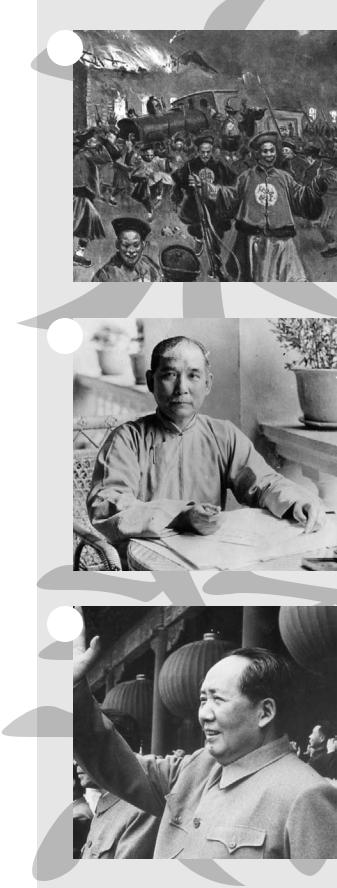
Japan and the Ryukyu Islands |
246 |
Korea and the Sino-Japanese War |
247 |
Reform and Upheaval |
248 |
The Hundred Days of Reform of 1898 |
249 |
The Boxer Rebellion |
251 |
Reformist and Revolutionist Movements |
|
at the End of the Dynasty |
253 |
Sun Yat-sen and the United League |
254 |
Sun Yat-sen |
255 |
Constitutional Movements After 1905 |
256 |
The Chinese Revolution (1911–12) |
257 |
Chapter 12: The Early |
|
Republican Period |
259 |
The Development of the Republic (1912–20) |
259 |
Early Power Struggles |
259 |
China in World War I |
260 |
Japanese Gains |
260 |
Yuan’s Attempts to Become Emperor |
261 |
Conflict Over Entry into the War |
262 |
Formation of a |
|
Rival Southern Government |
263 |
Wartime Changes |
263 |
Intellectual Movements |
264 |
An Intellectual Revolution |
264 |
Riots and Protests |
265 |
The Interwar Years (1920–37) |
265 |
Beginnings of a National Revolution |
265 |
The Nationalist Party |
265 |
The Chinese Communist Party |
266 |
Mao Zedong |
268 |
Communist-Nationalist Cooperation |
268 |
Reactions to Warlords and Foreigners |
269 |
Militarism in China |
270 |
The Foreign Presence |
271 |
Reorganization of the KMT |
271 |
Struggles Within the Two-Party Coalition |
273 |
Clashes with Foreigners |
273 |
KMT Opposition to Radicals |
273 |
The Northern Expedition |
274 |
Expulsion of Communists |
|
from the KMT |
275 |
251
255
267
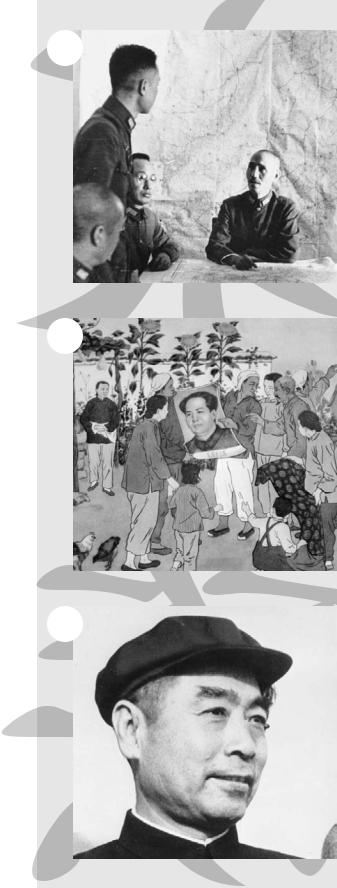
The Nationalist Government |
|
from 1928 to 1937 |
276 |
Japanese Aggression |
278 |
War Between Nationalists |
|
and Communists |
278 |
The United Front Against Japan |
280 |
Chapter 13: The Late Republican |
|
Period and the War against Japan |
281 |
The Early Sino-Japanese War |
281 |
Phase One |
281 |
Nanjing Massacre |
282 |
Phase Two: Stalemate and Stagnation |
283 |
Renewed Communist-Nationalist Conflict |
285 |
The International Alliance Against Japan |
286 |
U.S. Aid to China |
286 |
Conflicts Within the International Alliance |
287 |
Phase Three: Approaching Crisis (1944–45) |
289 |
Nationalist Deterioration |
290 |
Communist Growth |
290 |
Efforts to Prevent Civil War |
291 |
Civil War (1945–49) |
291 |
A Race for Territory |
292 |
Attempts to End the War |
293 |
Resumption of Fighting |
294 |
The Tide Begins to Shift |
296 |
A Land Revolution |
297 |
The Decisive Year, 1948 |
297 |
Communist Victory |
298 |
Chapter 14: Establishment |
|
of the People’s Republic |
300 |
Reconstruction and Consolidation, 1949–52 |
302 |
The Transition to Socialism, 1953–57 |
305 |
Rural Collectivization |
306 |
Urban Socialist Changes |
307 |
Political Developments |
307 |
Foreign Policy |
310 |
New Directions in National Policy, 1958–61 |
311 |
Great Leap Forward |
313 |
Readjustment and Reaction, 1961–65 |
316 |
285
301
310
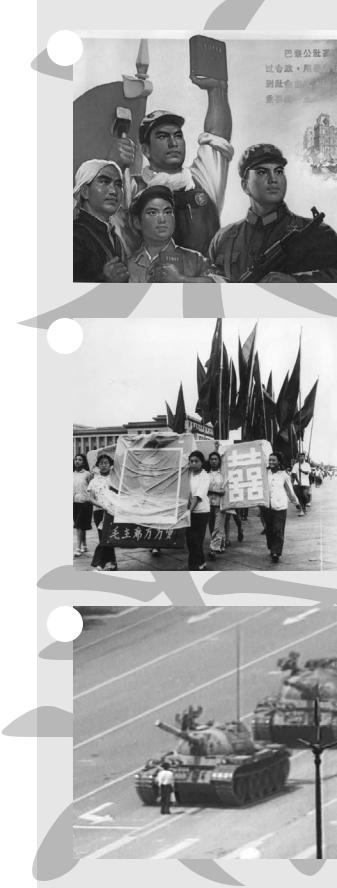
324
Chapter 15: China Since 1965 |
323 |
|
The Cultural Revolution, 1966–76 |
323 |
|
Attacks on Cultural Figures |
323 |
|
Attacks on Party Members |
325 |
|
Red Guards |
326 |
|
Seizure of Power |
327 |
|
The End of the Radical Period |
328 |
|
Social Changes |
330 |
|
Struggle for the Premiership |
331 |
|
Consequences of the Cultural Revolution |
334 |
|
China After the Death of Mao |
334 |
|
Domestic Developments |
335 |
|
Readjustment and Recovery |
335 |
|
Economic Policy Changes |
336 |
326 |
Political Developments |
338 |
|
Educational and Cultural |
|
|
Policy Changes |
340 |
|
International Relations |
340 |
|
Relations with Taiwan |
341 |
|
Conclusion |
342 |
|
Glossary |
346 |
|
For Further Reading |
348 |
|
Index |
349 |
|
339
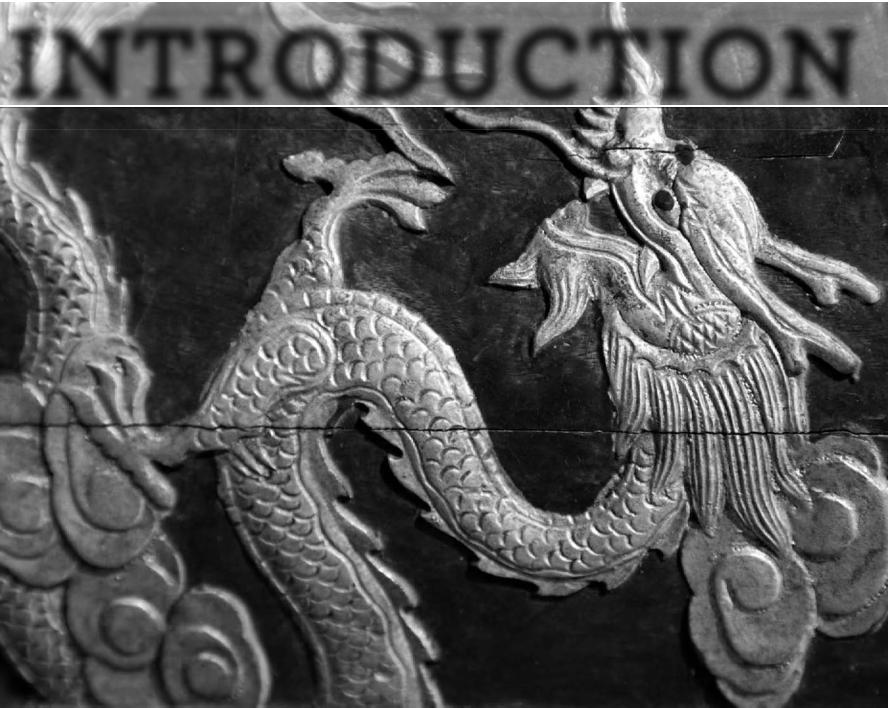
INTRODuCTION

Introduction | 15
On October 1, 2009, the People’s Republic of China celebrated its 60th anniversary with a stunning display of weapons, rumbling tanks, and smartly dressed soldiers under a blue sky in the capital city of Beijing. It was an impressive show of military might that displayed China’s rising power in the modern world. From a nation devastated by civil war and the ravages of World War II, China has become the world’s third-largest economy and a major player on the world stage. But the ability to renew itself is far from new for China. Despite upheavals that have shattered the country, China is unique among nations: its many cultural and economic accomplishments stretch across a continuous period, from its earliest recorded history, more than 4,000 years ago, to today. This book will reveal much about this exceptional nation and its long, varied history, which reaches back to one of the earliest periods in
world civilzation.
China was ruled for centuries by dynasties, each contributing to the country’s cultural development. The first Chinese dynasty for which there is archaeological evidence is the Shang dynasty (c. 1600–1046 BC). They left behind beautiful bronze objects, including massive ritual vessels and bronze chariots, which showed that Shang society was sophisticated and organized enough for its people to create large-scale foundries. Eventually, the Shang were conquered by their western neighbours, the Zhou (1046256 BC). The great philosopher Confucius was born during Zhou times.
The Qin dynasty (221–207 BC) was so influential that the name “China” is derived from Qin. Shihuangdi was its founder and most notable emperor. On the one hand, he was a cruel tyrant. On the other hand, changes he made during his reign helped to define China even today. The boundaries he set during his reign became the traditional territory of China. In later eras China sometimes held other territories, but the Qin boundaries were always considered to embrace the indivisible area of China proper. He developed networks of highways and unified a number of existing fortifications into the Great Wall of China, a UNESCO World Heritage site today. He established a basic administrative system that all succeeding dynasties followed for the next 2,000 years. His tomb near Xi’an contains one of China’s most famous treasures—6,000 life-sized terra-cotta statues of warriors.
The Han (202 BC–220 AD), the next great Chinese imperial dynasty established much of Chinese culture, so much so that “Han” became the Chinese word denoting someone who is Chinese. Under its most famous emperor, Han Wudi, China fought against its northern nomad neighbours, the Xiongnu, and took control of the eastern portion of the Silk Road, a trading route that allowed China to sell goods as far away as Rome. He also started China’s civil service system in which young men competed through exams for government jobs.
After the Han dynasty fell apart, China was a fractured state. This time was known

16 | The History of China
as the time of the Six Dynasties. Although China was not united in government, it retained its essentially Chinese character. This era was a time of development for two of China’s three major religions: Daoism and Buddhism (The other is Confucianism).
The short-lived yet significant Sui dynasty (581–618) unified the country after more than three centuries of fragmentation. One of the greatest accomplishments of the Sui dynasty was building a great waterway, the Bian Canal, which linked north and south China. This system, further enlarged in later times, was a valuable transportation network that proved to be extremely important in maintaining a unified empire.
The Sui set the stage for the succeeding Tang dynasty (618–907), which stimulated a cultural and artistic golden age. Some of China’s greatest poets, such as Li Bai and Du Fu, lived and wrote during the Tang dynasty.
Next came another time of political instability (907–960) during which three northern peoples, the Tangut, Khitan, and Juchen, occupied parts of China’s traditional territory. The Tangut became middlemen in trade between Central Asia and China. The Khitan founded the Liao dynasty by expanding from the border of Mongolia into southern Manchuria. This area remained out of Chinese political control for more than 400 years and acted for centuries as a centre for the mutual exchange of culture between the Chinese and the northern peoples. The Liao were overthrown by the Juchen.
The Song (960–1279) was one of China’s most brilliant dynasties. During the Song period, commerce increased, the widespread printing of literature became popular and a growing number of people became educated. An agricultural revolution, including cultivation of an early ripening strain of rice, produced enough food to feed a population of 100 million people—by far the largest population in the world at the time. Artistically, the Song dynasty marked a high point for Chinese pottery. But militarily, the Song were less powerful. During this dynasty the Juchen continued to control much of China’s central plains. This caused a spiritual crisis that led to a new form of Confucianism known as Lixue “School of Universal Principles,” which synthesized metaphysics, ethics, and self-cultivation, and became important in China for centuries to come.
In the late 12th and 13th century, Genghis Khan, the great Mongol war- rior-ruler, was slashing his way across Asia and Europe. He started the work of conquering the rich prize that was China, and began the Yuan dynasty (1206–1368) but was only partially successful. It wasn’t until his grandson, Kublai, took control that the Song dynasty was completely defeated—a fight that took several decades. Being ruled by a foreign invader was difficult for native Chinese, who were not allowed to hold the highest positions in court and were called “southern barbarians.” But at the same time, Yuan rule had certain benefits for the Chinese. The Mongols reunited China.

Introduction | 17
They left religion alone. A large, well-read bourgeoisie enjoyed novels and plays. Because the empire was so vast, China engaged in more extensive foreign trade than ever before, allowing the country to become richer and more stable.
Chinese rulers reclaimed leadership of the country during the Ming dynasty (1368–1644). During the Ming, China exerted immense cultural and political influence on East Asia. This era was famous for its brilliant art, especially craft goods, such as cloisonné and porcelain. The “willow pattern” porcelain wares became a famous export good to Europe.
The Qing dynasty (1644–1911/12) the last of China’s imperial dynasties, began when the Manchu, descendants of the Juchen, took over China. From the beginning, the Manchu made efforts to become assimilated into Chinese culture. These efforts bred strongly conservative, Confucian cultural attitudes in official society and stimulated a great period of collecting, cataloging, and commenting upon the traditions of the past. During this time, there was significant trade with other countries—in the 18th century, 10 million Spanish silver dollars a year flowed into China. In its early days, Qing China had a favourable trade balance, but gradually it became weak, and beginning in the 1820s, European powers such as Britain began demanding concessions and other special favours from China (including control of some Chinese territory). The Qing dynasty was not strong enough to resist. A series of brief wars and uprisings took place during the
19th century as Chinese rebelled against both Qing policies and these foreign incursions.
Finally, in 1912, the Qing dynasty abdicated and Yuan Shikai became president of China’s new republic. But when the Nationalist Party (Kuomintang, or KMT), made up mostly of former revolutionaries, won a commanding majority of seats in the new legislature and obstructed Yuan’s agenda, the president undermined parliament and eventually took on dictatorial powers. He then tried to appoint himself as emperor but died in 1916 before doing so. Still, Yuan managed to leave behind foreign debt, a legacy of brutality, and a country fracturing into warlordism.
On May 4, 1919, students organized protests and riots in the nation’s major cities, and waves of workers went on strike to pressure the government to oppose the decisions made at the Paris Peace Conference after World War I ended, especially the decision to allow the Japanese to keep control of valuable Chinese land, resources, and railroads that they had taken in the previous decade. This outburst led to the establishment of the Chinese Communist Party (CCP). After spending several years recruiting new members, the CCP began to compete with the KMT for control of China.
In 1928, the Nationalists formally established a reorganized National Government of the Republic of China. Meanwhile, Japan was moving aggressively to extend its power in Manchuria,

18 | The History of China
and nationalism was growing among the Chinese people.
Throughout most of the 1930s, the KMT clashed with the CCP. The communists established their own rival government in 1931 at several bases in rural areas of central China. In late 1934, the Nationalists forced the communists to abandon their bases. The communists fought their way across western China in what became known as the Long March. By 1936, the remnants of several Red armies had gathered into an impoverished area in northern Shaanxi and reorganized themselves. During the Long March, the communists developed cohesion and discipline. Mao Zedong rose to preeminence as a leader.
The Sino-Japanese War (which later developed into the Pacific theatre of World War II) began in 1937 with Japanese attacks near Beijing. The CCP and KMT formed an alliance (the United Front) to fight against the enemy, but during the war’s first year, Japan won victory after victory. By late December, the Japanese had invaded Shanghai and Nanjing. Between 100,000 and 300,000 people were massacred by Japanese soldiers in Nanjing. By mid-1938, Japan controlled the rail lines and major cities of northern China. The next years continued to be a bitter time, and the Chinese suffered terribly. Eventually, the alliance between the CCP and KMT began to fracture, as both sides fought to control territory. The Nationalist government became increasingly corrupt, while the communists, having survived
10 years of civil war, had developed a powerful discipline and sense of camaraderie. After the war ended with Japan’s defeat in 1945, the Nationalist government began to deteriorate.
In 1949, the communists took control, establishing the People’s Republic of China and installing Mao Zedong, the chairman of the CCP, as its leader. Using the Soviet model, Mao’s government wanted to focus on organizing China’s industrial workers. But four-fifths of China’s people were underemployed, impoverished farmers. To address this problem, Mao came up with the First Five-Year Plan (1953-57), which redistributed land and forced farmworkers into small agricultural collectives. This plan had some success in helping to reduce hunger. However, this success did not carry out in his next large program, the Great Leap Forward (1958–60). During that campaign, the large-scale collectives Mao had envisioned to increase China’s food were also pressed to engage in small-scale industrial production. However, agricultural output declined, and this, combined with a series of natural disasters that further ravaged crop production, led to mass starvation in the country.
Indeed, life under Mao was a time of constant social upheaval and uproar. Under his leadership, China went through one kind of social revolution after another. Posters extolling the virtues of the latest propaganda campaigns, with names like “Let a hundred flowers blossom,” “The Four Olds,” and “Bombard the

Introduction | 19
headquarters,” blanketed the country. Often, those who participated in one social movement were attacked in the next.
In 1966, Mao unleashed the most farreaching of his upheavals: the Great Proletarian Cultural Revolution, a time when many authors, scholars, schoolteachers, former party leaders, and other intellectuals were denounced as subversive to the country’s cause. Bands of Red Guards (paramilitary units of radical students) roamed the country attacking those whom they deemed unsuitable. Sometimes different Red Guard groups even attacked each other. Students, intellectuals, and party members were encouraged or forced to moved out to the countryside and told to “learn from the poor and middle-class peasants.”
The consequences of the 10 years of the Cultural Revolution were severe. In the short run, political instability produced slower economic growth. In the long term, the Cultural Revolution left a severe generation gap in which poorly educated young people only knew how to redress grievances by taking to the streets, an increase in corruption within the CCP, and a loss of legitimacy as China’s people became disillusioned by politicians’ obvious power plays. Perhaps never before had a political leader unleashed such massive forces against the system that he had created.
After Mao died in 1976 and the Cultural Revolution subsided, China’s
priorities changed. It began to reach out more to the world, and to develop as an economic powerhouse. In 1978, China formally agreed to establish full diplomatic relations with the United States. In education, top priority was given to raising technical, scientific, and scholarly talent to world-class standards. The collective farming system was gradually dismantled. Private entrepreneurship in the cities increased. It modernized its factories and developed its transportation infrastructure; its cities grew rapidly. China joined the World Trade Organization in 2001.
China faces many problems, among them serious environmental issues, widespread economic inequality, and a sometimes repressive government. Its image was tarnished in 1989, following the deaths of protestors in Tiananmen Square. Still, the world clamours for Chinese goods, and this has led to China becoming a major player on the world stage—it now has the world’s third largest economy and is among the top trading countries. China remains cohesive and vital, as it showed when it hosted the glittering 2008 Summer Olympics in Beijing and again demonstrated its ability to reinvent itself and to innovate, even after 4,000 years of history.
What follows is a more detailed narrative of China’s vast history with more comprehensive information on the dynasties, movements, and events that account for the nation’s rich history.
